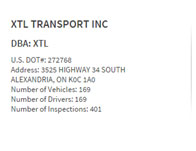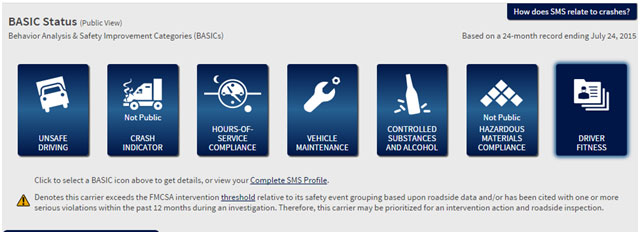The FMCSA (June 29,2015) has just released proposed changes to the Compliance, Safety, Accountability (CSA) program. The changes are reflected primarily in changing intervention thresholds for BASIC measurement categories in their Safety Measurement System (SMS).
A note about how the system works:
Keep in mind while reading this article that the SMS is a ranking system not a rating system. So if a threshold is set at 80%, say. It means that to “pass” you have to be ranked in the top 80% of all carriers for this BASIC.
Why the Changes?
The main changes fall on changing compliance thresholds. The FMCSA has taken a look at each of the BASICs in their Safety Management System (SMS) and correlated them to crash risk. If follows that higher crash risk BASICs should have a tighter compliance threshold while BASICs that have very low correlation to crash risk should have lower compliance thresholds.
HIGH CRASH RISK BASICs: Unsafe Driving, Crash Indicator, Hours of Service (HOS) Compliance
MEDIUM CRASH RISK BASICs: Vehicle Maintenance
LOW CRASH RISK BASICs: Controlled Substances, Hazmat Compliance and Driver Fitness
What are the Changes?
Intervention Thresholds at 65%: Unsafe Driving, Crash Indicator and HOS Compliance will all remain at 65%. That means if you are in the bottom 35% of all carriers you should continue to expect intervention activities.
Intervention Thresholds at 75%: Vehicle maintenance was previously 80%, meaning the bottom 20% of carriers would receive intervention. This is now changed to 75% meaning the bottom 25% of all carries will receive intervention. So, more carriers are likely to fall in the intervention category for this BASIC.
Intervention Thresholds at 90%: To reflect the lower crash risk, Controlled Substances, Hazmat Compliance and Driver Fitness will be lowered to 90% from 80% (I know that seems backwards!). This means that instead of the bottom 20% of carriers requiring intervention, only the bottom 10% will require intervention. So, less carriers are likely to warrant compliance interventions for these BASICs
Other Major Changes
The FMCSA is also proposing to segment Hazmat Compliance by vehicle type. Bulk Tank Carriers usually have very high compliance in this area, while packaged goods carriers often have trouble. This is because of the wide range of clients a packages goods carrier may have on a single vehicle as well as, being susceptible to many more opportunities for violations vs. a tank truck carrier. Since this is a ranking system, it’s unfair to compare bulk tank carries with packaged good carriers in the same ranking system.
Here at STL safety is always top concern.
XTL Transport Inc maintains a safety record below the intervention threshold in all categories. You can check out our profile at:
https://ai.fmcsa.dot.gov/SMS/Carrier/272768/Overview.aspx


